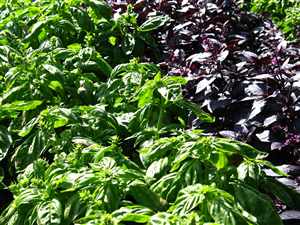Basil (Ocimum Basilicum)
Main Facts about Basil

Basil is an annual with leafy stems. The leaves are yellow-green to dark green and very fragrant. The flowers are small, white in color and arranged in a terminal spike.
There are purple varieties of Basil (Opal Basil). Lemon Basil, Anise Basil, Clove Basil, and Cinnamon Basil all have additional flavors similar to their names. Thai basil has additional licorice flavor. The most common type of Basil is Sweet Basil.
In Italy Basil is a sign of love; French call is a royal plant. In India it is a sacred herb dedicated to the gods Vishnu and Krishna.
Using Basil
It is recommended for digestive problems. Instead of an after meal mint tea try a cup of Basil tea to help digestion and reduce flatulence. It is also recommended for stomach cramps, vomiting, and constipation.
Basil has a slight sedative action and is sometimes recommended for nervous headaches and anxiety.
Basil is a good source of vitamin A, magnesium, iron, and many other nutrients that can help protect cell walls from free radical damage.
Recently, there have been several studies of the health benefits of the essential oils found in basil. These oils have been found to have anti-inflammatory and anti-bacterial properties.
It proves that ingesting basil in as many ways as possible, especially fresh, helps guarantee the safety of the food you bring to your table.
Basil essential oil has antifungal and insect-repelling properties.
Basil can be used for acne. Boil several fresh leaves in 1 cup of water for 10 min; let the liquid cool. Dip a cotton ball into the liquid, dab it gently on your problem zones, after 10 minutes wash with water; repeat once or twice a day.
According to recent studies, Holy Basil (Tulsi) has anti-anxiety effect.
Basil is a remedy for: Constipation
Cooking with Basil
Basil has a rich and spicy flavor. It is better used fresh. In general, Basil is added at the last moment, as cooking quickly destroys the flavor.
Basil is best stored in an oil, vinegar, or frozen paste.
How to grow Basil

It grows easily from seed. Sow it outdoors when there is no danger of frost and the soil has warmed to a temperature about 50F. Or plant it indoors and transplant after last frost. Use a moist soil. Cover the containers with clear plastic to prevent the loss of moisture. When the seedlings appear, loosen the plastic to allow some ventilation. When the seedlings leaves are opened, remove plastic completely.
To encourage a bushy plant, keep pruning. Once flowers appear on a stem, the plant stops growing leaves. To avoid it, cut the flower stems before they are fully mature.
Basil plants like moisture. If you live in a hot area, put mulch around them to keep the soil moist. Basil can be grown indoors in a pot. Put it in full sun and away from drafts.
| Barley grass |
Bilberry
|